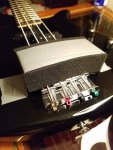Bruthish
Hair Metal Roxx!
I have been mixing for awhile off and on. By no means PRO, just amateur status. However, I have a hard time grasping the concept of how much low end to put into a song.
For example, I can mix a song to sound great to my ears and it sounds great in the car and on my system. When I play it on my cheap computer monitors w/sub, the low end(kick and bass) overwhelms the systems and sounds like hell. However, any commercial track I play sounds good on it. So the obvious adjustment would be to kick out some of the low end until it stops bottoming out the sub. But....when I do that the track is thin and lacks that bottom in comparison to the commercial tracks.
Is there any tricks or tips to magically get a great low end without overloading? I do research and just not getting clear answers.
Thanks
For example, I can mix a song to sound great to my ears and it sounds great in the car and on my system. When I play it on my cheap computer monitors w/sub, the low end(kick and bass) overwhelms the systems and sounds like hell. However, any commercial track I play sounds good on it. So the obvious adjustment would be to kick out some of the low end until it stops bottoming out the sub. But....when I do that the track is thin and lacks that bottom in comparison to the commercial tracks.
Is there any tricks or tips to magically get a great low end without overloading? I do research and just not getting clear answers.
Thanks




 Maybe this was more drastic for effect, but it seemed to be pretty much a standard move I thought.
Maybe this was more drastic for effect, but it seemed to be pretty much a standard move I thought.